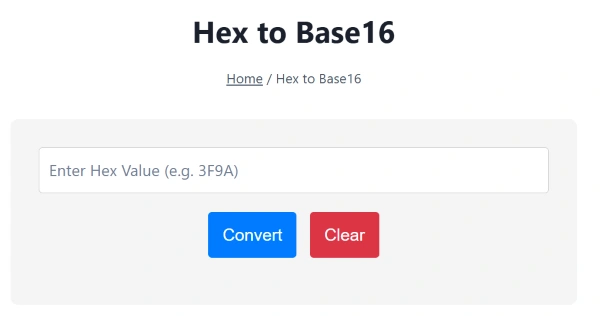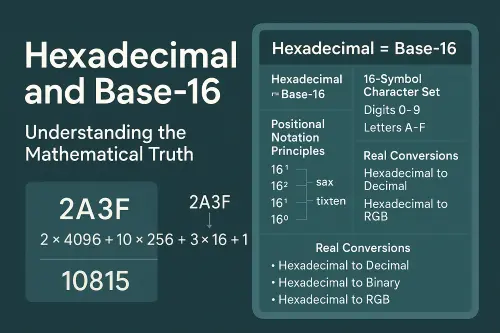Hex to Base16
Reverse Conversion Tool: base 16 to hexadecimal converter
Hexadecimal and Base-16: Understanding the Mathematical Truth
If you’ve landed on this page searching for a “hexadecimal to base-16 converter,” we have important news: hexadecimal IS base-16. They are mathematically identical concepts, not different number systems that require conversion between them. Let’s clear up this common misconception and explore what you’re actually looking for.
The hex to base16 converter image is shown below:

The Mathematical Reality: Hexadecimal = Base-16
Hexadecimal and base-16 refer to the exact same number system. This is not a matter of opinion or interpretation—it’s mathematical fact supported by:
- IEEE Computer Society standards
- International Organization for Standardization (ISO) definitions
- Academic computer science consensus
- Mathematical literature worldwide
The term “hexadecimal” comes from Greek and Latin roots meaning “sixteen,” while “base-16” is the mathematical descriptor for a positional numeral system using 16 distinct symbols. They describe the same mathematical concept using different terminology.
Why the Confusion Exists
Understanding why people search for hexadecimal to base-16 conversion helps us address the underlying confusion:
Educational System Variations
Some educational materials introduce these concepts separately, leading students to believe they’re different systems. In reality, they’re teaching the same concept using different names.
Software Implementation Differences
Different programming languages and applications may use varying notation styles:
- Standard notation:
3F2A - Prefixed notation:
0x3F2A - Hash notation:
#3F2A - Subscript notation:
3F2A₁₆
These are all representations of the same hexadecimal/base-16 value, just with different formatting conventions.
Regional Terminology Differences
Some regions or institutions may emphasize one term over another, creating false distinctions in learners’ minds.
Understanding Hexadecimal/Base-16 Fundamentals
Since hexadecimal and base-16 are identical, let’s explore this number system’s key characteristics:
The 16-Symbol Character Set
The hexadecimal system uses exactly 16 symbols:
- Digits 0-9: Represent values 0 through 9
- Letters A-F: Represent values 10 through 15
- Case variations: Both uppercase (A-F) and lowercase (a-f) are valid
Positional Notation Principles
Each position in a hexadecimal number represents a power of 16:
- Rightmost digit: 16⁰ = 1
- Next digit left: 16¹ = 16
- Next digit left: 16² = 256
- Next digit left: 16³ = 4,096
Example: The hexadecimal number 2A3F equals:
- 2 × 16³ + 10 × 16² + 3 × 16¹ + 15 × 16⁰
- 2 × 4,096 + 10 × 256 + 3 × 16 + 15 × 1
- 8,192 + 2,560 + 48 + 15 = 10,815 in decimal

Real Conversions You Might Actually Need
Since hexadecimal to base-16 conversion is impossible, here are the legitimate conversions you’re likely seeking:
Hexadecimal to Decimal Conversion
Converting hex to decimal is one of the most common operations. Use our Hexadecimal to Decimal Converter for instant, accurate results.
Manual Method:
- Identify each hex digit’s position value
- Convert letters to their numeric equivalents (A=10, B=11, etc.)
- Multiply each digit by its position value
- Sum all results
Hexadecimal to Binary Conversion
Each hex digit converts to exactly 4 binary digits, making this conversion straightforward. Our Hexadecimal to Binary Converter handles this automatically.
Conversion Table:
- 0 → 0000, 1 → 0001, 2 → 0010, 3 → 0011
- 4 → 0100, 5 → 0101, 6 → 0110, 7 → 0111
- 8 → 1000, 9 → 1001, A → 1010, B → 1011
- C → 1100, D → 1101, E → 1110, F → 1111
Hexadecimal Format Conversions
Transform hex data into various formats for different applications:
- Hexadecimal to ASCII Converter: Convert hex codes to readable text
- Hexadecimal to Base 64 Converter: Transform hex to web-safe encoding
- Hexadecimal to RGB Converter: Convert hex color codes to RGB values
- IP to Hexadecimal Converter: Transform network addresses to hex format
Practical Applications of Hexadecimal/Base-16
Understanding when and why hexadecimal is used helps clarify its importance:
Computing and Programming
Memory Addresses: Computer memory locations are typically expressed in hexadecimal because it’s more compact than binary but directly correlates to binary patterns.
Machine Code: Processor instructions and data are often displayed in hex format for debugging and analysis.
Configuration Values: Hardware settings, register values, and system parameters frequently use hexadecimal notation.
Web Development
Color Codes: HTML and CSS use hexadecimal color codes like #FF0000 for red, where each pair represents red, green, and blue intensity values.
Unicode Characters: Character codes are often expressed in hexadecimal, such as U+0041 for the letter ‘A’.
Cryptography and Security
Hash Functions: SHA-256, MD5, and other hash algorithms produce hexadecimal output strings.
Digital Certificates: SSL certificates and cryptographic keys are commonly represented in hexadecimal format.
Security Tokens: Authentication tokens and session identifiers often use hexadecimal encoding.
Hexadecimal Arithmetic Operations
Since hexadecimal follows standard positional notation rules, you can perform arithmetic operations directly in hex. Use our Hex Calculator Online for complex calculations.
Addition Example
3F2A
+ 1B8C
------
5AB6Subtraction Example
7FFF
- 2A3B
------
55C4For advanced operations including multiplication, division, and bitwise operations, our hex calculator provides instant results with step-by-step explanations.
Working with Different Hex Representations
Standard Notation
Simple hex digits without prefixes: DEADBEEF
Prefixed Notation
- 0x prefix:
0xDEADBEEF(common in C, C++, JavaScript) - & prefix:
&HDEADBEEF(Visual Basic) - $ prefix:
$DEADBEEF(assembly language)
Hash Notation
Used primarily for color codes: #FFFFFF
Subscript Notation
Mathematical notation: DEADBEEF₁₆
Validating Hexadecimal Input
When working with hex data, proper validation is crucial:
Valid Characters
- Digits: 0, 1, 2, 3, 4, 5, 6, 7, 8, 9
- Letters: A, B, C, D, E, F (case insensitive)
Invalid Characters
Any character outside the 16-symbol set is invalid hex input.
Length Considerations
Hex strings are often padded to specific lengths (2, 4, 8 characters) depending on the application.
Common Hexadecimal Patterns
Byte Values
Two hex digits represent one byte (0-255 decimal):
00= 0 decimalFF= 255 decimal80= 128 decimal
Word Values
Four hex digits represent one 16-bit word:
0000= 0 decimalFFFF= 65,535 decimal8000= 32,768 decimal
Color Codes
Six hex digits represent RGB color values:
#FF0000= Pure red#00FF00= Pure green#0000FF= Pure blue#FFFFFF= White#000000= Black
Educational Resources and Tools
Learning Hexadecimal Concepts
Interactive Tutorials: Step-by-step guides for understanding hex arithmetic and conversions.
Practice Problems: Hands-on exercises with immediate feedback to reinforce learning.
Visual Aids: Charts and diagrams showing the relationship between hex, decimal, and binary.
Practical Conversion Tools
Since you can’t convert hex to base-16 (they’re the same), explore these legitimate conversions:
- Decimal to Hex Converter: Convert decimal numbers to hexadecimal
- Binary to Hex Converter: Transform binary strings to hex format
- ASCII to Hex Converter: Convert text to hexadecimal representation
- Base 32 to Hex Converter: Transform Base 32 encoded data to hex
- Base 36 to Hex Converter: Convert Base 36 to hex representation
- Hex to Base 36 Converter: Convert hex to Base 36 representation
- Base 12 to Hex Converter: Convert Base 12 to Hex easily
Troubleshooting Common Misconceptions
“My tool shows hex and base-16 as different”
Some poorly designed tools may list them separately, but this is a design error, not a mathematical reality. Always verify against authoritative sources.
“I need to convert between hex formats”
What you likely need is formatting conversion, not number system conversion. This involves changing representation styles (adding/removing prefixes, changing case) while maintaining the same numerical value.
“Different systems use different hex”
While notation may vary, the underlying mathematical system remains identical. A hex value represents the same number regardless of whether it’s written as FF, 0xFF, or #FF.
Advanced Hexadecimal Operations
Bitwise Operations
Hexadecimal is ideal for bitwise operations because each hex digit represents exactly 4 bits:
AND Operation: A5 AND 3C = 24 OR Operation: A5 OR 3C = BD XOR Operation: A5 XOR 3C = 99
Use our Hex Calculator for complex bitwise operations with detailed explanations with this dedicated hex bitwise calculator tool.
Hex in Programming
Different programming languages handle hexadecimal notation differently:
C/C++/Java: 0xDEADBEEF Python: 0xDEADBEEF or 0XDEADBEEF JavaScript: 0xDEADBEEF Assembly: 0DEADBEEFh or $DEADBEEF
Best Practices for Hex Usage
Consistency in Notation
Choose one notation style and use it consistently throughout your project:
- Use uppercase for hex letters (A-F) in formal documentation
- Use lowercase for hex letters (a-f) in casual coding
- Always use the same prefix convention within a project
Documentation Standards
When documenting hex values:
- Clearly indicate the notation being used
- Provide decimal equivalents for important values
- Use consistent formatting throughout
Error Prevention
- Always validate hex input before processing
- Use appropriate data types for hex storage
- Implement proper error handling for invalid hex strings
Related Number System Conversions
Expand your number system knowledge with these related conversions:
- Octal to Hex Converter: Convert base-8 to hexadecimal
- Hex to Octal Converter: Transform hex to base-8 format
- Base64 to Hex Converter: Decode Base64 to hexadecimal
- Hex to Base32 Converter: Convert hex to Base32 encoding
